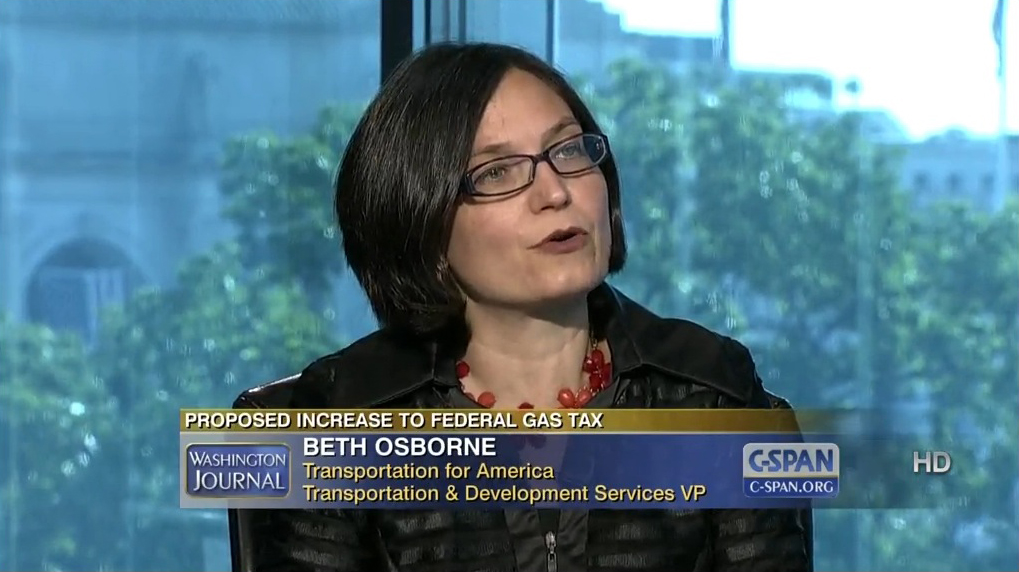
On C-SPAN, T4A’s Beth Osborne finds agreement with Heritage on HTF, walkability


Beth Osborne appearing on C-SPAN July 3, 2014. Click the image or here to watch the full video
Our compatriot Beth Osborne engaged in a spirited discussion on gas taxes and the crashing highway trust fund this morning on C-Span’s Washington Journal. Her co-panelist was Curtis Dubay, taxes and economic policy research fellow at the Heritage Foundation.
Dubay took less of a hard line than have some of his colleagues, who have suggested we could wind down the federal program and make the states take on everything themselves. (As an aside, can you imagine the gory fights in 50 legislatures as they try to raise gas taxes as much as 20 cents a gallon to replace the federal tax, on top of state gas taxes, which some have recently raised? How many legislative sessions would it take, and how many would just punt and let the highways, bridges and transit go to hell?)
As taxes go, Dubay said, the gas tax is a “good one”, because the people who use the resulting system are paying for it. Most people agree that infrastructure in a primary government responsibility. He even agreed a higher tax might be warranted, but only if it is restricted to highway construction.
Dubay complained that the gas tax has been diverted to “non-infrastructure purposes” like subways, ferries and road safety projects that save the lives of pedestrians and bicyclists (and motorists). To which Osborne responded:
Transit is a form of infrastructure. The purpose of the federal program is to move people and goods efficiently, not to require that people move a particular way. From the driver’s perspective it’s just as helpful to get somebody out of their way, particularly [those traveling] short distances. And it can be cheaper to move them outside their cars. … We’re looking for efficiencies and good outcomes in the program. These taxes are being used to move people the way they want to move.
There are lots of good reasons why federal gas tax dollars should be used to build and maintain a truly complete network. Transit projects in major cities make the morning commute possible for drivers, plain and simple, because without it gridlock would be absolute. Federal dollars were used to build roads that cut through neighborhoods without providing for the safety of people walking along or across them, and need to be fixed. Ferries, in states such as Washington, are part of the highway system, connecting roadways across bodies of water. These are not “diversions” from our surface transportation infrastructure; they are key components that must be part of a complete system that offers fair access for all.
In terms of who’s paying the federal gas-tax “user fee”— it’s everybody. You’re not exempt if you only use local roads and no federal highways in your commute. The cost of transporting goods, including gas and diesel taxes, is in the price of everything you buy. In the name of fairness, our taxes should be buying the safest, most efficient, most accessible system possible for all Americans – well-off or poor, young or old, whether living in cities, suburbs or small towns.
Today, market and demographic changes are demanding a new focus for our transportation investments, and that’s because … well, lets give Mr. Dubay the floor:
The market is solving the livability and walkability issue. People are moving in closer to cities. It’s a generational shift… . They are not living in the suburbs as much as they used to, largely because people don’t want to drive like they used to. Having a car and driving isn’t as romantic as it once was, that’s for sure.
If, indeed, people are going to be living in higher concentrations – and they are doing so in both cities and older suburbs – they will still need to get around. What they will need is a seamless, fully integrated network. Many will still own cars and drive them when it makes sense for them, paying gas taxes when they do. They will hope that when they need to use the highway, enough of their fellow residents will be using transit that there is actually room for them on the road.
The local leaders we work with know this, and that’s why they are trying to save the nation’s infrastructure fund from insolvency and win reforms that give them the latitude to do what they need to do. We’re glad to see folks at Heritage acknowledge the changes, and we hope that soon they will join us in declaring an end to the days of the government mandating a top-down, single-mode approach.



